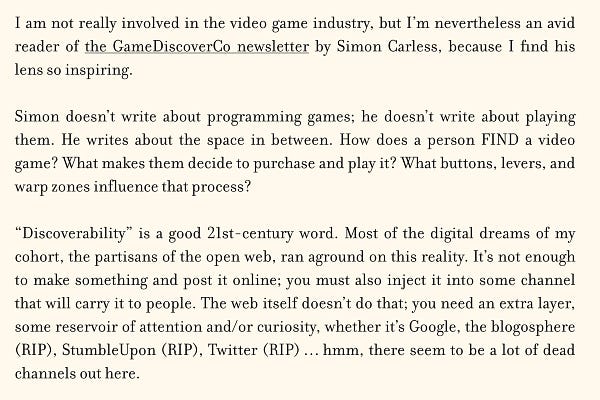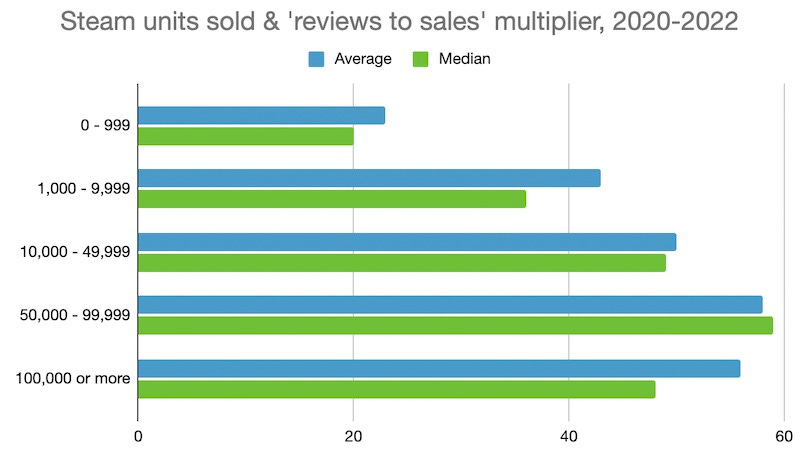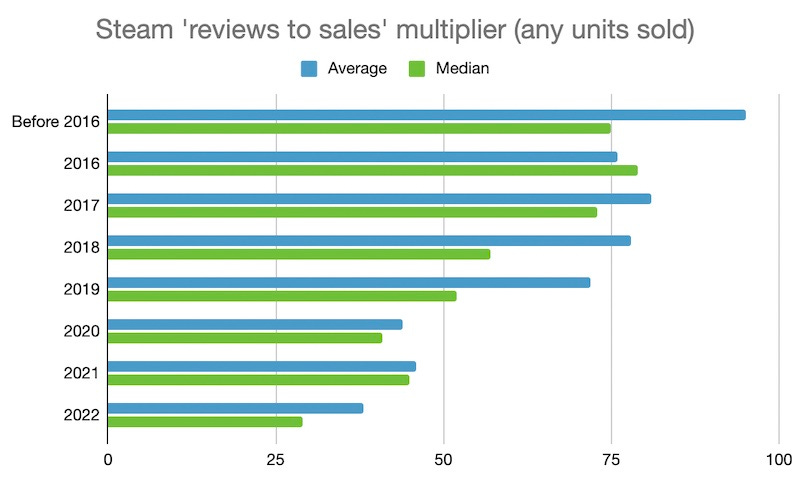Steam sales estimates: why game popularity matters!
Publikováno: 14.11.2022
Also: how games with big gameplay shifts add hook, and lots more.
[The GameDiscoverCo game discovery newsletter is written by ‘how people find your game’ expert & company founder Simon Carless, and is a regular look at how people discover and buy video games in the 2020s.]
The weekend? No more. The working week? Very much upon us. Once again, thanks for supporting myself and my colleagues at GameDiscoverCo (there’s four and a half of us nowadays!) by reading the newsletter, using our consulting & all that good stuff.
Before we start, shout-out to Griffin Aerotech, Dodge Roll & Devolver for shipping an original arcade lightgun game - Enter The Gungeon: House Of The Gundead - as a tie-in to the popular indie game. (This was originally revealed in 2019, and is finally now through production, post-pandemic.) We love it.
[Heads up: only a coupla weeks left on our 30% off dealfor new GameDiscoverCo Plus subs. You get an extra weekly newsletter (example) that goes deep on games & trends, a Steam data back end (video) with much useful info, & GameDiscoverCo Plus Discord access. Sign up..]
Steam sales estimates: beyond a simple multiplier!

How do you know how many people have paid for - or own - a game on Steam? Right now, there are two methods: either a) do a multiplier of a game’s Steam reviews, as GameDiscoverCo has previously surveyed for, or b) try to scan individual Steam user profiles to calculate overall owners, as sites like SteamSpy and GamingAnalytics do.
Both have their pluses and minuses. The ‘reviews multiplier’ - also called the Boxleiter number - is by far the easiest to work out. But… why do we have to keep contradicting our own Plus back-end estimates recently for new, popular games using it?
We realized one reason might be because most people want to know about medium and high-selling game multiples, not low ones. And most popular methods of estimating are based only around the year of release - for example 20-55x reviews as a paid owner estimate for a Steam game released in 2021, with a median of 30.
And in our Friday Plus-exclusive newsletters, what often say - based on our clients’ data and some public metrics - is ‘actually the multiplayer for a hot new game is closer to 60x over time’. (And starts higher than that, since reviews take about 5-7 days to ‘catch up’ after initial release.)
But can we get any data to back up this hunch? Yes we can, and here’s the ‘recent years’ (2020-2022) results from our recent anonymous survey of 200-ish Steam games - which sold anything from 20 units to 16.8 million units (?!):
As you can see, it’s games that have sold less than 1,000 units that have the low multiple, with a 20x median. But it quickly steps up, with a 36x median multiplier for 1,000-9,999 units sold, a 49x median for 10,000-49,999 units sold, and 59x for 50,000-99,999 units sold. (It comes down slightly to 48x for games with >100k units sold!)
Why would this be, though? We can think of a couple of reasons:
With much smaller games, devs make sure that their friends and acquaintances review it, of course. And if the game is super niche, you want to tell people and recommend to others. Those must be the biggest driver of ‘smaller game’ reviews.
More importantly, the bigger you get, the more 'casual' players you have. We’ve already proved - at least to our satisfaction - that casual players leave shorter reviews. Isn’t it also likely that many of them leave no reviews at all?
At a very high level of sales, a slight reverse effect seems to kick in - more people are keen to leave reviews because it’s the new big thing. Some of these titles have >90% Positive reviews too, which we suspect is an indicator of a lower multiple.
BTW, our limited data seems to imply that Early Access games do get 20-30% less reviews per sale than 1.0 games, as you might expect. So if you see a game is in EA, add 25% to your previous multiplier estimates.
And yep, this ties in with data like The Wandering Village, which had 100,000 copies sold in its first week and got 1,148 Steam reviews during that time - an 87x multiplier. So sure, maybe it was a 60x for a popular game, plus a bit for Early Access?
So that’s an interesting starting point using this data. We’ve also made the raw survey results available(Google Drive link) if anybody wants to do anything fancier with it - or refute any of the above. But we think we’ve proven some causation here.
And yes, we think the median for all games released in 2022 could still be 30 across all games, and review ratios have come down over time. Here’s the data showing this - 2022 median was 29x in our data set:
But it’s just a question of what you want to look at. And if the games with low multipliers are majority those which sold less than 1,000 copies, it’s important to acknowledge that. We’ll be changing our Plus back-end calculation soon to reflect this.
Having said all of this, of course, there are still going to be obvious outliers. For example, Elden Ring just got to 17.5 million units LTD across all platforms, and somehow has over 400,000 Steam reviews, wow.
It’s likely this is because Elden Ring is a ‘game that people want to talk about’ - with >90% Positive reviews.And so 1 in 20-25 players leave a review, compared to the 1 in 50-60 that is more normal with a large-scale game. (We don’t think it’s sold >10 million units on Steam.)
So this is why all estimates can and should be taken with a grain of salt. In theory, you might be able to combine the ‘review multiplier’ estimate with the ‘look at Steam profiles’ estimate* to make something better than both. But that’s for another day…
[*There are a couple of disadvantages to the ‘scan public Steam profiles’ method - primarily that Steam profiles are private as default from April 2018, which can skew things, and ‘owners’ also includes things like Humble Choice key redemptions, which can be inflationary.]
Why big game mechanic combos mean big hooks..
Something we don’t talk about much is how game design can reinforce hook. I was part of an interesting discussion on a Discord about why Peglin (Peggle x RPG) ended up doing well on Steam - maybe 200k copies sold? But Roundguard (also a Peggle RPG!) hasn't broken out in quite the same way on PC - perhaps 15k units LTD on PC?
Quoting her with permission, Kitfox’s co-founder Tanya Short identified something smart, which is that Roundguard has ‘subtle power-ups’ for you to gradually progress through the game. This is still super fun to play* - but it’s less exciting to stream.
On the other hand, Peglin has power-ups which stack and upgrade in more radical ways, and can majorly change the meta - see the above ‘4 million damage’ Peglin video. (And here’s another 600k damage one from yesterday with 22k YouTube views.)
This reminded me of the fact that The Binding Of Isaac has done well in the long-term in part because it has such large, complex and buildable power-ups which completely change ‘runs’. It can be genuinely surprising every time you play it.
So while this may not be possible for all games you work on, it’s a good idea to consider much more aggressive/unexpected upgrades in a replayable game. If properly balanced, it’s potentially viral - and helps people see something different every time.
Two other great examples of this factor at work: Tanya adds: “My other example of crazy-different synergistic runs would be Luck Be a Landlord.” And duh, Marvel Snap has a whole heap of these ‘unexpected cards combos/locations cause interesting results’ game mechanics, which the devs have obviously spent a ton of time balancing.
[Just a final shout-out for Roundguard, which is also on Apple Arcade and console, and I’ve personally played a lot. I love the ‘Peggle hybrid’ microgenre, and y’all should check it out too! And a gradual power-ups approach can still work fine - Spelunky is a good example of this.]
The game discovery news round-up..
Finishing up the newsletter for this fine Monday, here’s some of the notable game discovery and platform news which turned up - while you were nappin’ or workin’:
Ever unique, Nintendo’s Shigeru Miyamoto, while commenting that it’s easier than ever to offer backwards compatibility for games, also said: “When we release new hardware in the future, we would like to showcase unique video games that could not be created with pre-existing hardware.” Gotta respect the stretch to innovate?
Apple’s upcoming AR device plans are well sketched-out in this Bloomberg newsletter: “The most interesting [new Apple] job listing is one that specifically calls out the development of a 3D mixed-reality world, suggesting that Apple is working on a virtual environment that is similar to the metaverse.” The device “is likely to be priced between $2,000 and $3,000” to start out, though.
We’re digging Xbox’s transparency around player moderations & complaints, “detailing the actions it takes to protect players from inappropriate behaviour, misconduct and more on its platform.” There were 7.31 million ‘enforcement actions’ & 4.5 million players had their accounts suspended, which sounds like.. a lot?
October 2022’s U.S. game hardware & (select) game software $ are upon us, via this mammoth Mat Piscatella Twitter thread, and revenue was $4.3 billion (flat YoY). Ther’s double-digit % growth in PC/console ‘content spending’ - cos Call of Duty: Modern Warfare 2 turned up a month earlier than CoD: Vanguard last year.
Microlinks: Meta appears to be testing a new Remote Display app for Quest headsets that brings a Mac or PC into Quest Home; Google Play to pilot third-party billing in new markets like the U.S., as Bumble joins Spotify as an early tester; The Verge didn’t dig the Quest Pro as a standalone device, giving it 4/10.
The nominees for The Game Awards - happening Dec. 8th - have been revealed, with Sony (20), followed by Annapurna and Nintendo (11) leading nominations by publisher. Noms for best ‘indie’, btw, comprise Cult Of The Lamb, Neon White, Sifu, Stray, and Tunic - all fine games in their own right.
Could there really be 100 million+ people with access to Apple Arcade? That’s what Sports Interactive’s Miles Jacobson anecdotally said alongside the launch of Football Manager Touch on AA. (If that’s correct, it’s cos people get the service bundled with Apple One. So it’s an odd - if interesting - comparison point.)
Unity’s CEO John Riccitiello comes in for a bit of a kicking in this Bloomberg piece: “Depending on whom you ask, since taking the helm in 2014, Riccitiello has transformed Unity into either a tech powerhouse or a midtier marketing business pretending to be more.” (Possibly a little bit of both, but def. with a business hat on.)
We hear a lot of about Netflix’s mobile (and cloud?) games, but let’s not forget its ‘interactive TV’ efforts, of which Triviaverse is the latest: “Guided by your host, a mysterious pair of spooky glowing eyes, you’ll pick if you’re playing solo or against someone else. Each round features an increasingly difficult series of trivia questions, and you’ll have a minute to answer as many as you can correctly” using a virtual D-pad.
Practical video microlinks: Evolve PR on capturing in-game footage for your game; Nordcurrent’s Andrius Mackevičius on making a good Steam page; Derek Lieu & Chris Zukowski help Noclip’s Danny O’Dwyer clip fix up the Steam page for his experimental Cryptic Sea collab Stunt Derby.
Finally, since we’re occasionally allowed to succumb to people saying nice things about us, author Robin Sloan had some nice, outsider-y views re: the space we cover:


[We’re GameDiscoverCo, an agency based around one simple issue: how do players find, buy and enjoy your premium PC or console game? We run the newsletter you’re reading, and provide consulting services for publishers, funds, and other smart game industry folks.]

